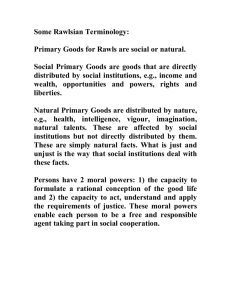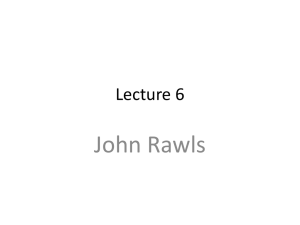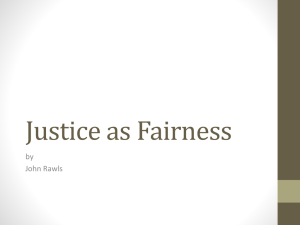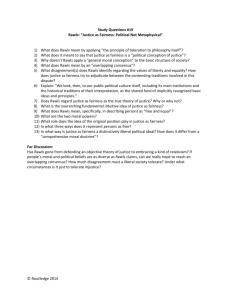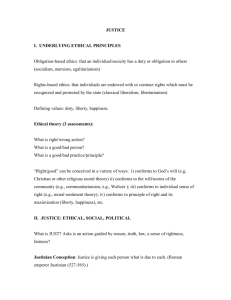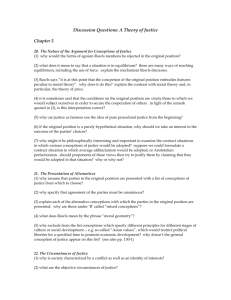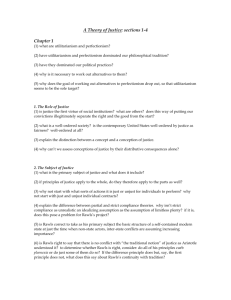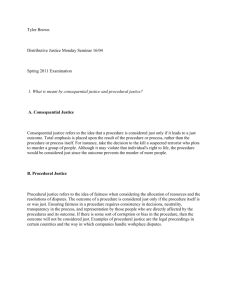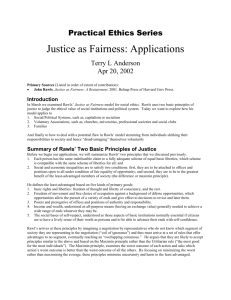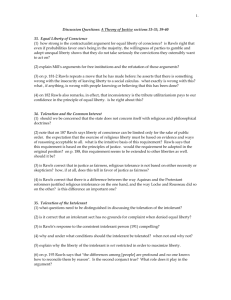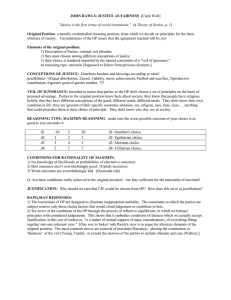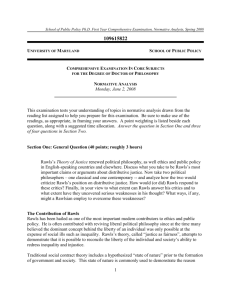Rights-Based Ethics Rights
advertisement
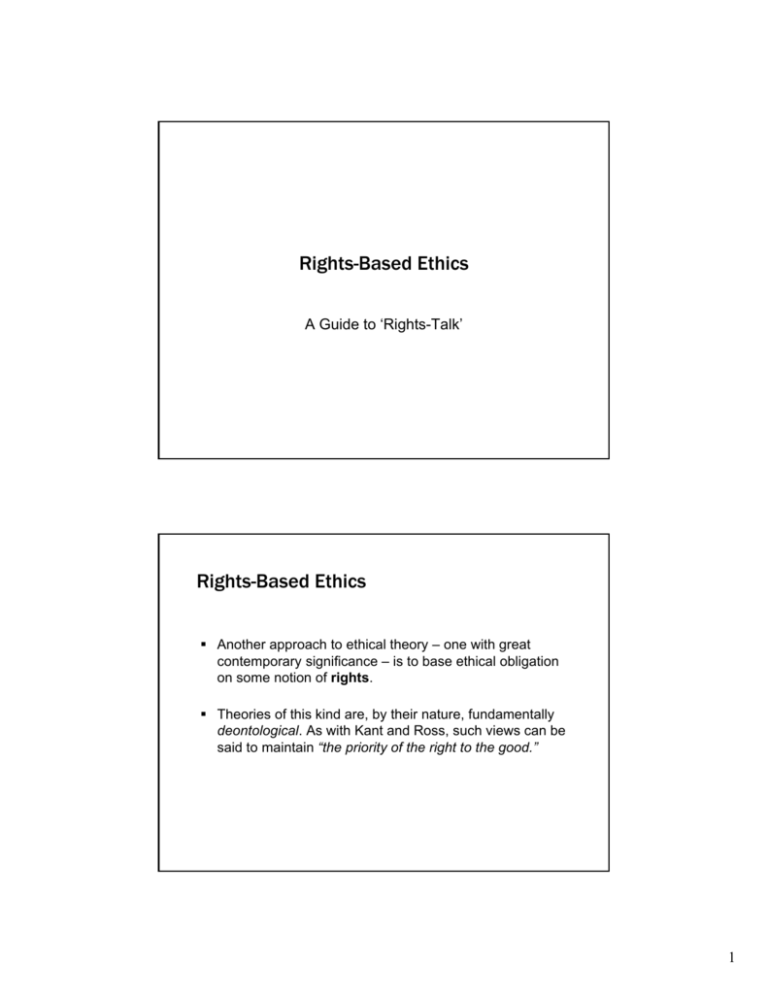
Rights-Based Ethics A Guide to ‘Rights-Talk’ Rights-Based Ethics Another approach to ethical theory – one with great contemporary significance – is to base ethical obligation on some notion of rights. Theories of this kind are, by their nature, fundamentally deontological. As with Kant and Ross, such views can be said to maintain “the priority of the right to the good.” 1 What Are ‘Rights’? 1. A right is an entitlement to something E.g., legal rights guaranteed by the Canadian Charter of Rights and Freedoms (1982): In Canada, legal sanctions may apply in cases where rights to life, liberty or security of the person have been found to be violated. A package of basic human rights is proposed in documents such as the UN Universal Declaration of Human Rights (1948) and the Helsinki Accords (1975). Violations of human rights may not (yet) be subject to legal sanction, but instead are more like (putative) moral norms: People who violate them are subject to our praise and blame, our disrespect. 2. Rights imply correlative duties E.g., My right to freedom from physical harm imposes on others a duty not to physically harm me; My right to free speech imposes on others a duty not to prevent me from speaking; My property right in X imposes a duty on others not to trespass upon or interfere with my use and enjoyment of X. 2 Hohfeld’s (1919) Classification A and B are CORRELATIVE iff the presence of the one [of A or B] in an individual X implies the existence of at least one other person Y in which the other [of A or B] is present. A and B are OPPOSITES iff the presence of the one in an individual X implies the absence in himself, X, of the other Negative vs. Positive Rights Negative Rights: Freedom from interference; an entitlement to be left alone. (E.g., freedom of expression, privacy rights) Positive Rights: Freedom to do or to attain something; an entitlement that somebody else do something for/to you. (E.g., the right to an education, the right to medical care) 3 Some Considerations… Some theorists (e.g., hard-core libertarians) argue that all (or most) moral and political rights, properly understood, are negative rights (i.e., there are no legitimate positive rights, except in private law). How so?: Any putative positive right involves the violation of someone’s negative rights (e.g., through taxation) In liberal societies, this view strongly conditions regulatory and administrative law—economic liberties (negative rights) limit the power of regulators. (e.g., intellectual property rights, assessment and licensing of technologies, product labeling etc.) Rights and the ‘Social Contract’ The rights-based approach to moral and political theory has its roots in the work of Thomas Hobbes (1588-1679), John Locke (1632-1704) and Jean-Jacques Rousseau (1712-78). Each of these philosophers are among the founders of the social contract (‘contractarian’) tradition. This tradition understands the political authority to create and enforce laws and, by extension, the force of moral norms to be grounded in an explanatory fiction called the 'social contract’… 4 Hobbes and the ‘State of Nature’ In order to understand the nature of ethical and political norms, imagine a condition in which these did not exist… In the pre-political state of nature which precedes civil society there was both absolute freedom and a state of constant war, a “war of all against all.” In the state of nature, says Hobbes, the life of man is “solitary poor, nasty, brutish and short”—it is not a good deal, so to speak, for anyone … The social contract is a tacit agreement among individuals to give up some degree of the absolute liberty that they possessed in the state of nature, provided others do so as well, in exchange for something (more) valuable: In the political case: A system of legal rights guaranteed (and enforced) by the state. In the general, social case: A system of moral norms, mutually enforced by everyone. 5 Why Accept the Social Contract? One answer (John Locke’s): Because legitimate civil government exists to protect our inalienable natural rights to life, liberty and property; government can only be made legitimate through the consent of the governed. Another answer (Hobbes’): Because it’s a better deal than the state of nature… Public Goods Specifically, the Hobbesian account suggests that some things that everyone has reason to value (such as peace, order and security) are in the nature of public goods. Public Goods: Goods that are non-excludable in provision and non-rival in consumption—goods that will not be adequately supplied by individuals acting solely in their own interest. Moral norms (and coercive laws) exist to provide us with public goods that we could not obtain otherwise. 6 Rawls’s Theory of Justice John Rawls's (1921-2002) theory follows the social contract tradition and develops a contractarian view of justice in which principles of justice are the output of a special sort of social contract. Justice, according to Rawls, is the solution to a problem: People (notoriously) disagree about values (i.e., about the nature of the good life and about how benefits and burdens of social cooperation ought to be distributed), yet they have an interest in securing the benefits of cooperation… Outline of Rawls’s Theory Recall yet again the expression “the priority of the right to good.” We may strongly disagree about what is good (you think that modesty is good, I think that sensual pleasure is good; you want ecstasy, I want sobriety), but we may at least be able to agree on some minimal account of what is right. Society, on Rawls’s view, is a cooperative venture between free and equal persons for their mutual advantage; cooperation makes life better (recall Hobbes) because it increases the stock of primary goods… 7 Primary Goods Whatever it is rational to want, irrespective of whatever else you want. (e.g., health, material resources, rights, social bases of self-respect, etc.) Rawls's basic idea is that we can identify an acceptable conception of justice by asking what rights and what principles for the distribution of primary goods it would be reasonable for all members of society to agree to. Rawls identifies justice with fairness. If everyone accepts that the rules are fair and the rules are applied consistently, then we have fairness… The Setup But how do we know what principles are fair? How do we determine what reasonable people would agree to? Rawls’s (rather clever) suggestion is that we can see for ourselves what ought to count as fair principles by performing a thought experiment. Rawls: Imagine what principles would be chosen be people in the following special (imaginary) situation… 8 The Original Position (OP) Your task: To choose the basic principles by which the “basic institutions” of society will governed. To ensure impartiality, you are placed under special conditions… All knowledge of your tastes, preferences, talents, handicaps is hidden from you so as to remove factors which might bias your decision in your favour. You do, however, have knowledge of issues which would not be biasing (social scientific knowledge, knowledge about what human beings need in order to live, etc.). The Veil of Ignorance Persons in the original position are thus said to be under the 'veil of ignorance'. They do not know their interests, their place in society, their personal characteristics or their particular conception of the good. That is, they are mutually disinterested moral agents (recall Mill). Yet they have the capacity to understand, apply, and act from a concept of justice and a conception of the good. They have no way off knowing, or determining the odds, who they will turn out to be once the veil of ignorance comes off: You could be, winner or loser, a beggar or a millionaire, etc.. 9 Perfect Procedural Justice The OP though experiment is meant to model (albeit imperfectly) what Rawls calls “perfect procedural justice” The basic idea: “I cut, you choose” By choosing the right procedure, injustice is made selfdefeating. Rawls argues that people in the original position would choose certain principles of justice, rather than some other ones (e.g., strict equalitarianism or utilitarian principles). Moreover (since choosers in the OP have no way of predicting where they will end up in the social hierarchy) he argues that they will adopt a maximin choice strategy. So what specifically will people in the original position decide upon? In other words, what are the principles of justice, according to Rawls? 10 Rawls's Principles of Justice The First Principle (The ‘Liberty’ Principle) Each person has an equal right to the most extensive scheme of equal basic liberties compatible with a similar system of equal liberty for all. The Second Principle Social and economic inequalities are to be arranged so that they are both: a) to the greatest expected benefit of the least advantaged (the “Difference Principle”) and b) attached to offices and positions open to all under conditions of fair equality of opportunity. Priority Rule The two principles are in ‘lexical’ order. The first principle has priority over the second, so that all citizens are assured the equal basic liberties; similarly, part (b) of the second principle has priority over part (a), so that the conditions of fair equality of opportunity are guaranteed for everyone. If these principles characterize, or very nearly characterize, the “basic institutions” of some society, then that society is just. These principles are the outcome of a kind of bargaining process (though it is not proper bargaining, since individuals do not know their own interests), but the duty to abide by them does not itself derive from the contract. Instead, citizens can simply recognize for themselves that the rules are fair and, accordingly, agree to be bound by them. 11
